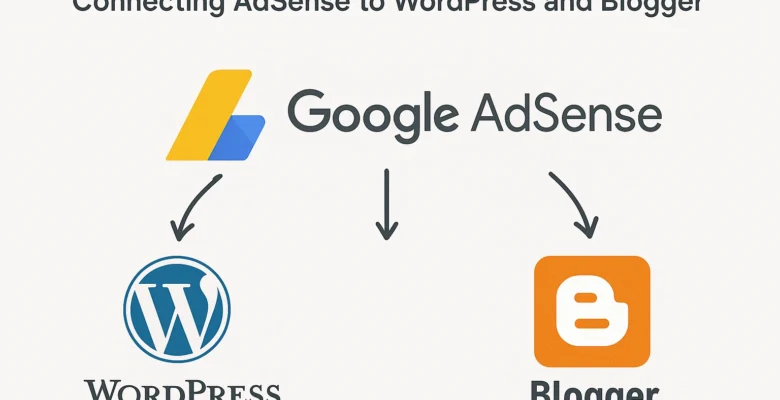How to Connect AdSense to Your WordPress and Blogger Site (2025 Guide)
Introduction
Monetizing your blog or website has become increasingly popular in 2025, and Google AdSense remains one of the most reliable ways to generate income online. Whether you run a WordPress site or a Blogger blog, connecting AdSense enables you to display ads that earn revenue whenever visitors interact with them.
In this guide, we’ll cover how to connect AdSense to WordPress and Blogger, step-by-step setup instructions, optimization tips, and common troubleshooting solutions for beginners.
Why Connect AdSense to Your Website?
Connecting AdSense to WordPress or Blogger offers several advantages:
- Passive Income: Earn money automatically from ad impressions and clicks.
- Customizable Ads: Choose between text, display, or responsive ads that suit your website’s layout.
- Performance Tracking: Access detailed reports on ad performance to optimize revenue.
- Trusted Network: Benefit from Google’s large advertiser base for high-paying ads.
Integrating AdSense is essential for bloggers and website owners looking to monetize content efficiently.
Requirements Before Connecting AdSense
Before you apply for AdSense, make sure your website meets the following requirements:
- Content Quality:
- Articles must be original, informative, and engaging.
- Avoid duplicate or low-value content to prevent rejection.
- Domain Age:
- For Blogger: Some countries require at least 6 months of active blogging.
- For WordPress: A custom domain is recommended with at least 3–6 months of content.
- Policy Compliance:
- Your site must adhere to Google AdSense Program Policies.
- No adult content, copyrighted material, or prohibited topics.
- Ownership Verification:
- Ensure full control of your domain and website hosting.
By meeting these requirements, you increase the chances of a smooth AdSense approval process.
Step 1: Create a Google AdSense Account
- Visit Google AdSense.
- Click Sign Up Now and log in with your Google account.
- Enter your website URL (WordPress or Blogger).
- Provide accurate payment information for receiving earnings.
- Submit your application and wait for approval, usually within 1–3 days for Blogger and 1–2 weeks for WordPress.
Tip: Regularly check your email for approval updates and ensure your site remains live and content-rich during the review process.
Step 2: Connect AdSense to Blogger
Since Blogger is owned by Google, connecting AdSense is straightforward:
- Log in to your Blogger dashboard.
- Navigate to Earnings → Sign Up for AdSense if you haven’t applied yet.
- Follow the on-screen instructions to link your account.
- Once approved, go to Layout → Add a Gadget → AdSense.
- Choose your preferred ad format (responsive is recommended) and placement.
- Save changes and preview your site to ensure ads appear correctly.
Tip: Use in-content ads to increase visibility and earnings.
Step 3: Connect AdSense to WordPress
For WordPress, the process varies depending on whether you use WordPress.com or WordPress.org.
WordPress.com
- Make sure your plan supports monetization (Premium or higher).
- Go to My Site → Monetization → AdSense.
- Link your Google account and follow the setup instructions.
WordPress.org
- Install a plugin such as Site Kit by Google or Ad Inserter.
Site Kit Method:
- Install and activate Site Kit by Google.
- Connect your Google account.
- Enable AdSense in Site Kit settings.
Manual Code Method:
- Copy the AdSense ad code from your account (Ads → By ad unit → Get Code).
- Go to Appearance → Widgets → Custom HTML, or use a plugin to place ads in your desired location.
Tip: Place ads in high-traffic areas like the header, sidebar, or within articles for better revenue.
Read also
Step 4: Optimize Ad Placement
Proper ad placement is crucial to maximize earnings:
- Above the fold: Ads visible without scrolling perform better.
- In-content ads: Place ads between paragraphs for higher CTR.
- Sidebar ads: Effective for desktop viewers.
- Responsive units: Ensure mobile optimization.
- Avoid overloading: Too many ads can reduce user experience and violate AdSense policies.
Step 5: Track and Improve Performance
Once your AdSense account is active:
- Access your AdSense dashboard to monitor performance metrics.
- Track CTR (Click-Through Rate), RPM (Revenue per 1000 impressions), and Page Views.
- Experiment with ad formats, placement, and styles to improve revenue.
- Focus on generating more organic traffic, which increases ad impressions and earnings.
Tip: High-quality content and regular posting improve overall AdSense performance.
Common Problems and Solutions
- Ads Not Showing:
- Ensure the ad code is correctly added and your site is approved.
- Account Rejection:
- Review Google’s policies, remove prohibited content, and reapply.
- Low Earnings:
- Optimize ad placement, use responsive ads, and increase traffic through SEO and social media promotion.
Frequently Asked Questions (FAQ)
Q1: Can I connect AdSense to multiple websites?
Yes, but each site must meet Google’s eligibility requirements and get approved individually.
Q2: How long does AdSense approval take?
Approval may take 1–3 days for Blogger and 1–2 weeks for WordPress.
Q3: Do I need a custom domain for WordPress?
Yes. Google prefers custom domains over free subdomains.
Q4: Can I remove or reposition ads later?
Absolutely. Use your dashboard or plugin to manage ad placement anytime.
Q5: How much can I earn from AdSense?
Earnings depend on traffic, niche, ad placement, and user engagement. High-traffic blogs in competitive niches earn more.
Conclusion
Connecting AdSense to WordPress and Blogger is an essential step for monetizing your content. By following this guide, ensuring compliance with Google policies, and optimizing ad placement, you can turn your website into a reliable source of passive income.
Start integrating AdSense today and watch your blogging efforts pay off!
